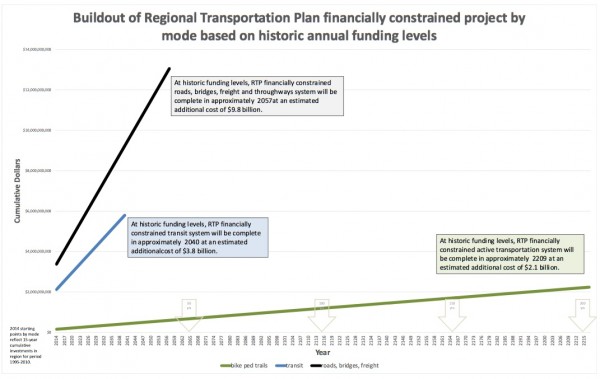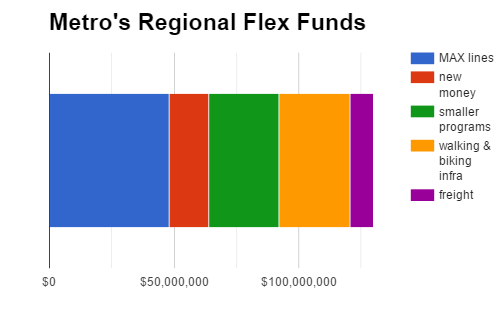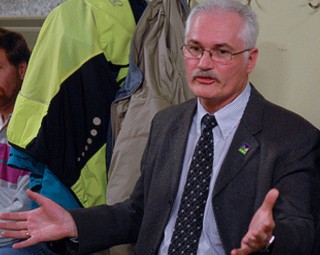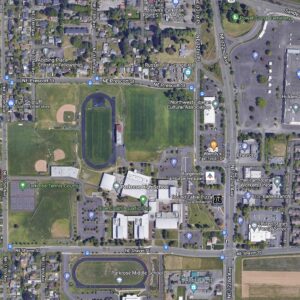
(Photo: J.Maus/BikePortland)
A two-year campaign for regional funding of better biking and walking near schools, backed by the Bicycle Transportation Alliance and other advocacy groups, is in tatters.
“We got left on the cutting room floor.”
— Gerik Kransky, Bicycle Transportation Alliance
Though the most recent federal transportation bill sent $16 million of new flexible money to regional government Metro, Bicycle Transportation Alliance Advocacy Director Gerik Kransky said a Metro proposal circulated last Friday would dedicate none of that to the “Safe Routes” infrastructure program proposed by the BTA.
The organization had organized 3,500 residents to send postcards and emails to Metro’s elected officials in its support.
Among many attempts to demonstrate support, the coalition organized and videoed an evening meeting in East Portland where one person after another testified in five languages that they feared to walk on the streets near their homes.
Metro’s proposal might even increase the amount of money going to freight-related projects. That’s even though five of Metro’s seven elected councilors told BikePortland earlier this month that they would probably not support slicing off more of this program for motor vehicle travel when the state and region already get hundreds of millions of dollars each year for that purpose.
“These are the only sort of flexible dollars that we have in the region,” Kransky said Wednesday. “This is the wrong place to go for those new freight projects.”

At recent spending rates, the region’s active transportation network won’t be built until the year 2209. The region’s current road plans would be finished by 2057, and its mass transit plans by 2040.
Metro council could decide to veto proposal
The proposal circulated Friday could send up to $12.5 million of flexible dollars to freight projects, compared with $9.23 million if the current freight program were simply adjusted for inflation.
How could this happen even though every Metro councilor we spoke with a few weeks ago said they would almost certainly oppose dedicating a larger share of flexible money to freight?
In part, the answer is that the Metro council itself doesn’t have direct control over federal transportation spending. Instead that money is allocated by a 17-member Metro committee called JPACT, the Joint Policy Advisory Committee on Transportation, which is made up mostly of elected officials from local governments.
But the Metro council does have one bit of control over JPACT: it could vote to veto the JPACT decision and send it back for revision.
Advertisement
That almost never happens. Craig Dirksen, the Metro councilor who chairs JPACT (and casts the deciding vote there in the event of a tie) told us he’d be “very surprised” if the council were to override JPACT on this issue.
“The way we like to do business is we have conversations with one another and we come to consensus before we vote, so that everybody can be satisfied with what comes out of the discussion,” Dirksen said.
In other words, Metro — the only elected regional government in the country — strives to be a no-drama zone.
All the sitting Metro councilors, with the possible exception of President Tom Hughes, could be described as progressives on transportation issues. Four of the seven (Sam Chase, Carlotta Colette, Kathryn Harrington and Bob Stacey) tend to strongly support infrastructure that reduces the region’s auto dependence. But the agency’s culture of consensus (and the theoretical threat of a suburban revolt against the agency) means that officials who see ever-expanding auto infrastructure as essential to the regional economy have substantial influence, too.
The structure of JPACT also gives more influence to people who live in less populated areas. Multnomah County gets one JPACT vote for its 775,000 residents; Clackamas County gets one vote for its 395,000.
Metro vote set for April 21

The Bicycle Transportation Alliance, whose campaign for Safe Routes has been underwritten in part by the American Heart Association, does seem to have scored one much smaller victory: up to $2.1 million in new Metro support for Safe Routes programming in schools, enough to create walking and biking education and encouragement programs around the region like those the BTA currently provides in Portland schools.
Kransky said the BTA is glad to have that in the proposal, but described it as a small silver lining. The For Every Kid Coalition (led by the BTA along with Upstream Public Health, the Safe Routes to School National Partnership, Oregon Walks, OPAL Environmental Justice Oregon, the Asian Pacific-American Network of Oregon and the Community Cycling Center) had asked Metro for $15 million for Safe Routes infrastructure.
“We got left on the cutting room floor,” he said.
There’s still a possibility that Metro could de-fund its other active transportation priorities in the coming years in order to guarantee projects near schools. And it could guarantee that its upcoming transit projects include lots of walking and biking projects that help people reach transit stations.
But neither of those options would meaningfully increase the amount being spent on walking or biking — even as the region considers tying up some of its scarce flexible funds so it can take out long-term loans that would increase the amount it spends on motor vehicles.
The JPACT vote is April 21. The For Every Kid Coalition is pushing a last-ditch effort on social media to block the proposed increase in freight funding.
— Michael Andersen, (503) 333-7824 – michael@bikeportland.org
BikePortland can’t survive without subscribers. It’s just $10 per month and you can sign up in a few minutes.
Correction 1:40 pm: An earlier version of this post said $17.5 million in new flexible funds will be available from the federal government. It’s more like $16 million.






Thanks for reading.
BikePortland has served this community with independent community journalism since 2005. We rely on subscriptions from readers like you to survive. Your financial support is vital in keeping this valuable resource alive and well.
Please subscribe today to strengthen and expand our work.
How much more is going to transit? Are Metro’s transit funds used for operations or capital projects?
I don’t think Metro’s money can be spent on transit operations. Primarily it goes toward planning like SW Corridor and Powell-Division.
In this case the new transit money would go to TriMet to let it take out loans to actually build those projects. This would tie up a large share of these flex dollars for transit until 2034 … something most of the Metro council basically has said they could live with.
What’s odd here, as far as the council is concerned, is the increased spending on freight.
By Federal law, through the Federal Transit Administration, a division of the US DOT, 83% of transit funds are spent on capital projects, including vehicles; 15% on maintenance and operations; and 2% on security. Most of TriMet’s operations funding comes from the payroll tax and farebox revenue.
I still don’t understand what spending money on freight routes means. Are these special streets that are designated as freight routes so they get extra money for what? More lanes? Thicker Pavement, flattening out the curbs so trucks can drive over them easier when turning? Or is it money to repair cracks in the asphalt caused by trucks? Or is it money to pay for picking up all the discarded retread casings the litter the highways when they fly off trucks.
“freight projects” is just a new, more politically palatable way to talk about highway and freeway widening. Just like they use “Safety projects.” Don’t be fooled. look at the projects and follow the money.
How about as a freight project, we implement congestion pricing on the highways for private automobiles, freeing up space for freight?
Toll the freight and pass the costs to the consumers. I don’t need to pay for dragging other people’s geegaws from china to the landfill.
Follow the money, indeed. The only “vitcory” “for bicycling” that the BTA scored just happened to be the tiny bit of funding that they, themselves, will probably benefit from. Not surprising.
I would like to know more about this, too. I think there are actually projects that primarily speed truck freight: for example, a new traffic signal on an access road in an industrial area, making it so you don’t have to wait a long time to make a left turn.
I’m pretty sure it’s accurate that freight customers are the ones lobbying for this spending on “freight.” But major freight customers (Intel, Fred Meyer) are also destinations for many auto trips.
If you really wanted to reduce truck travel times through the metro area, you’d put a decongestion charge on busy roads to deter non-essential auto trips, or create exclusive bus-and-truck lanes on Powell or Barbur or 82nd. Strangely, I never hear about freight advocates pushing for either of these things.
important points michael. thank you.
there are projects that do focus specifically on freight. However what I think is happening is that well-meaning freight advocates push for those projects while more politically-oriented players take the “freight!” mantra and run with it. they then get way too fast and loose with what a “freight project” really should be because they allow it to bend toward their personal bias of wider roads and freeways.
electeds and bureaucrats and transportation planners/experts could instead hear these needs from freight advocates and educate them on solutions that would actually help them – like congestion tolls, reducing SOV trips, increasing bikeway quality where/when it makes sense, and so on. But that response depends on those electeds/planners to actually believe in that stuff themselves which they don’t yet. ugh. the systemic inadequacies are so frustrating..
“I would like to know more about this, too. I think there are actually projects that primarily speed truck freight: for example, a new traffic signal on an access road in an industrial area, making it so you don’t have to wait a long time to make a left turn. …” andersen/bikeportland
A list of relatively minor improvements to help keep freight moving, I can believe( all together, still adds up to a lot of mone.). Big projects on the order of highway and freeway widening, no, unless specific details are provided to verify that is the kind of project to which the money for ‘freight’ is going.
I think the big issue for freight, is traffic congestion of the type that means stop and go traffic. More exits off the highways and freeways may help alleviate some of that congestion. Freeway widening is big, very costly projects. Some so called ‘highways’, the two lane country road converted to four lanes plus, are more likely widening candidates that could benefit the freight biz, depending on specific circumstances. It could be worthwhile to look at exactly what freight type projects Metro believes the money should go to.
Freight takes precedence. It’s a fiction these days, but Metro says that the fiction must be considered factual. Bikes and those on foot go to the back of the line…again. How do we convince the system that the people matter? This is so illogical that even Mr. Spock would find it hard to understand the reasoning for this.
Remember how the councilors vote when they are up for re-election.
Great idea, but it seldom works. They always seem to get re-elected no matter how bad they are.
We need to all get on our phones and computers to let our Metro representatives know how we feel. They need to hear from us directly.
http://www.oregonmetro.gov/about-metro/metro-council/find-your-councilor
shameful
Can anyone tell me how many kids actually end up riding to school, after their Safe Ride experience? Does anyone actually keep track, or is it more of a ‘feel good’ program?
A school that implements a comprehensive Safe Routes to School initiative with engineering improvements plus education and encouragement would result in a 43 percent increase in walking and bicycling rates (over five years). [source: http://saferoutespartnership.org/blog/it%E2%80%99s-official-safe-routes-school-proven-work%5D
But that’s based on the actual implementation of engineering improvements.
Budgets are priorities. Look at how we prioritize healthy transportation decisions by our young people. Is it any wonder that over half of all adults are now either diabetic or pre-diabetic?
But diabetes treatment is big biz…
Yes! many BILLIONS with the FDA blocking any cures.
BNSF and Union Pacific have to pay to maintain their tracks and rights of way, why are we subsidizing truck freight? They should pay for access to the roads. Sure the cost would be passed on to the ultimate consumer, but frankly I’d rather pay a little more for my consumption goods and less on taxes for roads. It would also level the playing field between road and rail freight.
It would also make local production more competitive, bolstering the local economy instead of putting out tax money directly into the pockets of national corporations.
I thought the 10 cent gas tax would pay for the Safe Routes to School. Portland Tribune article from today says “That is expected to raise $64 million over four years, with $28 million going to safety projects. Of that amount, $16.9 million will support Vision Zero projects and the rest is for Safe Routes to School and Neighborhood Greenway projects. “
Different money, and only funds programs in the city of Portland.
That’s right! It would pay for infrastructure near some Portland schools.
This proposal, were Metro to fund it, would pay for infrastructure near *more* Portland schools, and also near schools elsewhere in the region.
The region has a lot of schools.
About 400, in fact. Only around 100 of those are in Portland.
10 year old killed in Gresham, on “accident “. So of course we spent money on getting trucks places, instead of getting kids places out of the way of the trucks. This is one of the saddest articles I’ve read on BP in a long time 🙁
Jonathan, didn’t you just report on a huge (was it $167M?) unexpected (secret) windfall ODOT received from the federal govt? And that they’d decided (secretly) to use most of it on freight? If this is the case, why would Metro or anyone being throwing more money at freight?
Simple. The Feds say that freight goes first. By this same reasoning, you can’t put bike lanes on Powell / US 26 because “it’s the main highway to Madras,” as somebody from ODOT said last year. Therefore, a Safe Route to School that crosses a designated freight corridor must give way to freight when funding and routing decisions are made. US 30A / Lombard is the best example of a designated freight corridor. ODOT doesn’t want bikes there because the Federal policy says they can’t.